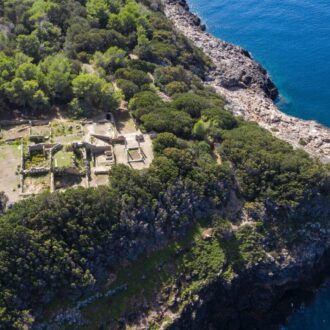Itinerari
Itinerario di Giannutri
Start from
Cala Spalmatoio
Giannutri is the "archaeological island" par excellence of the Tuscan Archipelago. The large Roman villa owned by the Domizi Enobarbi family occupies a large area of the north-eastern part of the island, with sprawling terraces which lead down to the sea.
The road linking Cala Maestra and Cala Spalmatoio can be freely visited without the need for a guide. The two bays are both suitable for swimming.
For safety reasons, visits to the Roman villa are only permitted for visitors accompanied by a guide.
The itinerary begins at Cala Spalmatoio, which is the disembarkation point for ferries from Porto Santo Stefano. After crossing the small village and its main square (where there is a grocery store and a bar), follow itinerary 501, which crosses the island from south to north.
Once on the path, the first remains of the Domizi Enobarbi villa can be seen. These reticulated brick structures of the service areas are located close to the mooring point at Cala Spalmatoio.
The walk continues towards the small plateau that houses the heliport, the highest point reached on the walk, and descends towards Cala Maestra. The bay overlooks Giglio and contains remains of the Roman villa, including a capital supported by a contemporary concrete column. The rocky walls framing the cove are dotted with the remains of imposing Roman masonry structures, belonging to service buildings and working areas.
From Cala Maestra, the itinerary continues towards the residential area of the Villa degli Enobarbi, flanking the area of the ancient cisterns. Access beyond the gate of the residential area is only available to visitors who have booked a guide through the Tuscan Archipelago National Park website or associated guide services. (EXTERNAL LINK)
The effort required to reach the villa is repaid when you access the magnificent Roman ruins. A monumental staircase introduces us to the peristyle area, where the raised columns surrounding the pool project the view of the blue sea and the nearby island of Giglio. Terraces with basins, wide corridors and stairways once covered in polychrome marble (including some original slabs) guide us through a labyrinth of luxury and give us a good idea of the luxury and wealth of the Roman aristocracy during the imperial period.
1ª tappa
The Villa of Giannutri
Giannutri, off the mass tourism trail, has been prized since ancient times as an ideal place for relaxation. One of the most scenic maritime villas in the whole archipelago.

2ª tappa
Cala Maestra
Cala Maestra opens out towards Giglio and has a pebbled beach where you can admire the sea and the remains of the Roman villa on the northern side of Giannutri.

3ª tappa
Cala Spalmatoio
This small hamlet is home to a few houses, a bar and a grocery store overlooking the square. The pebble beach is one of the few convenient accesses to the sea on Giannutri and in Roman times was used as a port, connected to the large villa.

